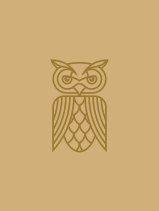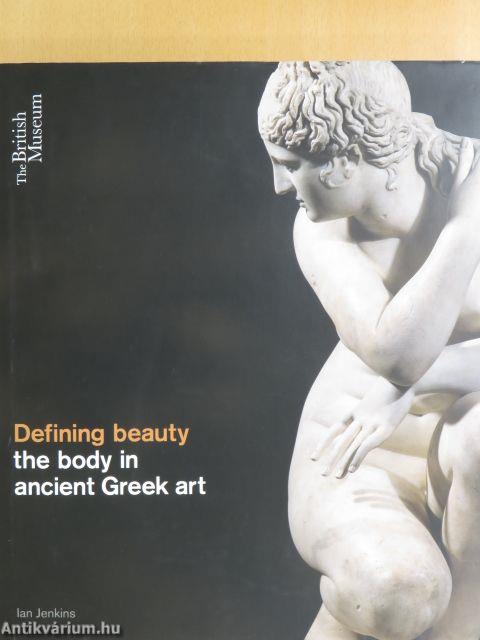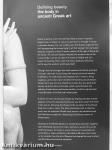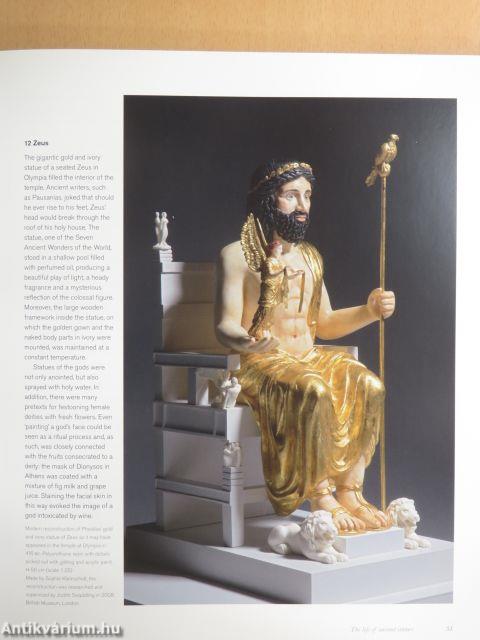1.067.937
kiadvánnyal nyújtjuk Magyarország legnagyobb antikvár könyv-kínálatát

VISSZA
A TETEJÉRE
JAVASLATOKÉszre-
vételek
Defining beauty the body in ancient Greek art
Kiállítási katalógus
| Kiadó: | The British Museum |
|---|---|
| Kiadás helye: | London |
| Kiadás éve: | |
| Kötés típusa: | Fűzött kemény papírkötés |
| Oldalszám: | 256 oldal |
| Sorozatcím: | |
| Kötetszám: | |
| Nyelv: | Angol |
| Méret: | 29 cm x 25 cm |
| ISBN: | 978-0-7141-2287-8 |
| Megjegyzés: | Színes képekkel. Kiállítási katalógus. |
naponta értesítjük a beérkező friss
kiadványokról
naponta értesítjük a beérkező friss
kiadványokról
Előszó
TovábbFülszöveg
Defining beauty the body in ancient Greek art
Greek sculpture is full of breathing vitality and yet it reaches beyond mere imitation of nature to give form to thougtit in works of timeless beauty. For over 2,000 years the Greeks experimented with representing the human body in art that ranges from prehistoric abstract simplicity to the full-blown realism of the age of Alexander the Great. The ancient Greeks invented the modern idea of the human body in art as an object of sensory delight and as a bearer of meaning. Their vision has had a profound influence on the way the western world sees itself.
Through word and image, this book explores the Greek portrayal of human character in art, along with sexual and social identity. In athletics, the male body was displayed as if it were a living sculpture, and victors were rendered immortal by actual statues. Human form was not only shared by mortals but also gods and heroes, while the forces of chaos, which could threaten the stability... Tovább
Fülszöveg
Defining beauty the body in ancient Greek art
Greek sculpture is full of breathing vitality and yet it reaches beyond mere imitation of nature to give form to thougtit in works of timeless beauty. For over 2,000 years the Greeks experimented with representing the human body in art that ranges from prehistoric abstract simplicity to the full-blown realism of the age of Alexander the Great. The ancient Greeks invented the modern idea of the human body in art as an object of sensory delight and as a bearer of meaning. Their vision has had a profound influence on the way the western world sees itself.
Through word and image, this book explores the Greek portrayal of human character in art, along with sexual and social identity. In athletics, the male body was displayed as if it were a living sculpture, and victors were rendered immortal by actual statues. Human form was not only shared by mortals but also gods and heroes, while the forces of chaos, which could threaten the stability of both divine and human worlds, could be represented in combinations of animal and human parts.
A series of lively introductory essays by leading scholars reveals aspects of how the Greeks themselves saw the human form both in life and art, following the thread of the reception of the Greek body into modern times. The book concludes with a reflection upon how the authentic Greek body came to be identified with the Parthenon sculptures, displacing all previous canons of Greek taste.
Drawing on the British Museum's outstanding collection, together with celebrated pieces from other institutions around the world, Defining beauty: the body in ancient Greek art is published to accompany a major exhibition at the British Museum that invites us to consider how the art of Greece has shaped the way in which we think about and look at ourselves.
With over 200 illustrations Vissza
Témakörök
- Idegennyelv > Idegennyelvű könyvek > Angol > Művészetek > Művészettörténet, általános
- Idegennyelv > Idegennyelvű könyvek > Angol > Művelődéstörténet
- Művelődéstörténet > Eszmetörténet > Művészetek
- Művelődéstörténet > Egyéb
- Művészetek > Művészettörténet általános > Múzeumok, képtárak > Külföldi > Európai
- Művészetek > Művészettörténet általános > Idegen nyelv > Angol
- Művészetek > Művészettörténet általános > Művészettörténet > Külföldi
- Művészetek > Művészettörténet általános > Korszakok, stílusok > Ókor > Görög
- Művészetek > Művészettörténet általános > Kiállítások, aukciók, katalógusok > Külföldi
Megvásárolható példányok
Nincs megvásárolható példány
A könyv összes megrendelhető példánya elfogyott. Ha kívánja, előjegyezheti a könyvet, és amint a könyv egy újabb példánya elérhető lesz, értesítjük.












